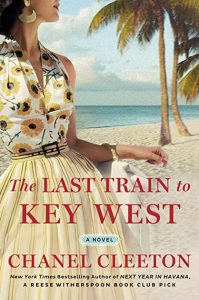For Chanel Cleeton’s third book, The Last Train to Key West, we journey back to the fictional Perez family to follow another one of its members. The Perez family is a wealthy, influential Cuban family that owns sugar fields. Where the first novel in the series followed dual timelines of late 1950’s Cuban Revolution and the modern era just after the death of Fidel Castro; and the second book set during the fraught Cuban-American relations of the 1960s; now we leave Cuba for the Depression-era Florida Keys.
Who the Narrators Are in The Last Train to Key West:
The Last Train to Key West goes slightly different in terms of narrators, compared to the first two. Whereas those had their narrators as being members of the Perez family, this book doesn’t. Consisting of three women for narrators, only one of them is a Perez, the other two having no ties to the family. The only Perez narrator, Mirta Perez, in the Keys for her honeymoon, follows her marrying an Italian New Yorker mafioso, to pay off her father’s debts. Her father and the rest of the family had supported the former Cuban dictator, and fell out of favor when the new regime of American-backed Batista (who was overthrown by Castro in 1959), took over in 1930.
And because The Last Train to Key West doesn’t solely revolve around the Perez family, here the only mentions of the family are rarer and only through what Mirta says or remembers. It also makes her the only Cuban character, everyone else white.
The second narrator is Helen Berner, who is nine months’ pregnant with her abusive husband’s child. She works as a waitress in Key West, and throughout the book, spends an odd amount of time fantasizing her husband’s death.
The third narrator is Elizabeth Preston, belonging to the family that was introduced in the second book, also becoming the next family to have Prestons appear in multiple books. She comes to the Keys to look for her long-lost brother, who’s supposed to be working on building a railroad, having fled the man she’s engaged to. Her fiance had saved her family when they lost money in the stock market crash and the Preston men all died.
The Last Train to Key West itself:
When I first read the premise of The Last Train to Key West, I thought it would be that the three women would be together for the entire length of the book, but no. They each have their own storyline and only have brief interactions with each other to set the story up (Elizabeth and Helen, Helen and Mirta, and Mirta and Elizabeth), but that’s all.
The book is set during Labor Day 1935, and while everything seems nice, it’s not. A hurricane takes place, and everyone gets caught up in it. The three women all have problems they go through and dangers to face of varying sorts, adding an action sort of feel to it, as if surviving a hurricane weren’t enough.
My Opinion of The Last Train to Key West:
 While the idea of the series is supposed to revolve around the Perezes, Mirta the only Perez takes the backseat, and Helen becomes the leading narrator. Because the book is historical fiction, it’s based on historical events. But other than the mentions of the Machado-Batista incident, events of The Last Train to Key West don’t revolve around Cuban events, since it’s set in the Florida Keys.
While the idea of the series is supposed to revolve around the Perezes, Mirta the only Perez takes the backseat, and Helen becomes the leading narrator. Because the book is historical fiction, it’s based on historical events. But other than the mentions of the Machado-Batista incident, events of The Last Train to Key West don’t revolve around Cuban events, since it’s set in the Florida Keys.
But events that do take place are ones I hadn’t heard of until I picked up the book. I didn’t know that there had been a 1935 Labor Day hurricane, which ended up being one of the strongest and deadliest in US history. Nor did I know that about a third of the victims were veterans of the first world war. With the veterans’ story an integral part of the plot, they had come down to work on Flagler’s railroad, which because it was destroyed in the hurricane, was replaced by the now-Overseas Highway, the original plan of the railroad.
Because it is a Chanel Cleeton novel, each narrator of course has a man tagging along with her, each character tangled up and having ties both near and distant to other main characters as well as background ones. The way it’s all done and written and revealed is interesting and shocking as the story goes on, which kept me reading.
The descriptions of the story are vivid, from the deplorable camps the vets lived in while working on the railroad to each character going through the hurricane itself. The hurricane feels lifelike, as well as the tidal wave that followed right after.
Each narrator has a romance with the tagging-along man, which is cringey and eye-rolling, especially given that there’s a large age gap between the narrators and their man (another thing Chanel Cleeton likes, massive age gaps), but it still develops nicely and unfolds throughout the story, weaving against the backdrop of the hurricane.
She does a good job of making you feel immersed in the story as it goes on, so you feel nervous when there’s danger and excitement when the rare, good thing happens. Cleeton does a nice job of mixing fiction and bringing to life another Perez (even though the family didn’t make up the entire plot), as well as the events of the hurricane and the atrocities the veterans went through.
Should You Read The Last Train to Key West?
If you are a fan of the Florida Keys and events taking place there, even Cuban fiction, as well as historical fiction, then you will enjoy The Last Train to Key West.






